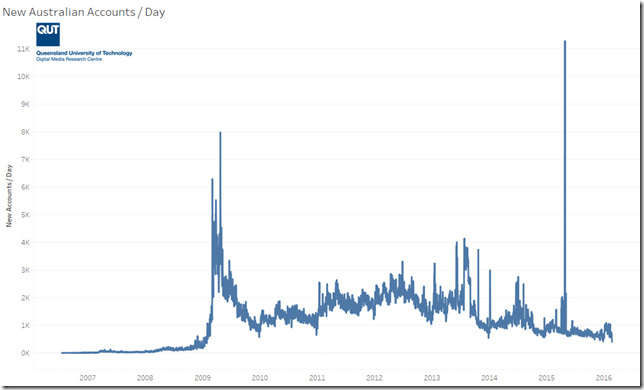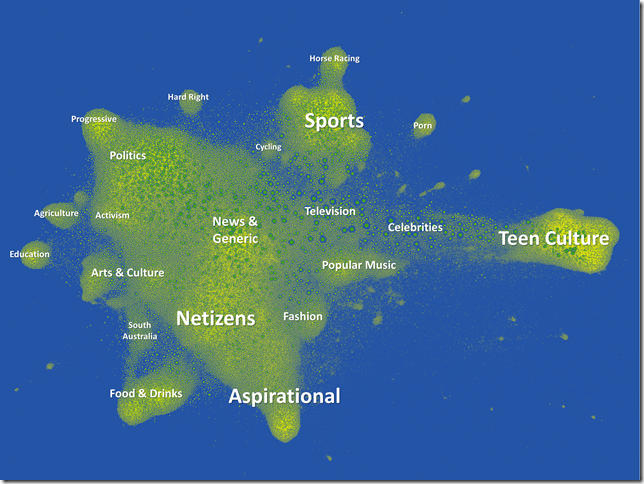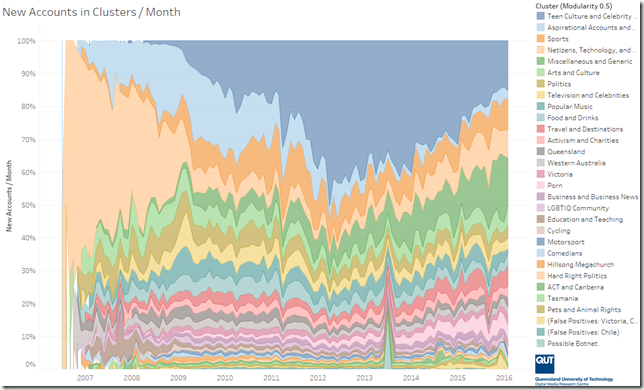Twitter in Australia: How We’ve Grown and What We Talk About
There are plenty of assumptions and not a great deal of reliable data about how we use social media. Twitter, for example, is variously accused of being a haven for leftist outrage and a cesspool of alt-right fascists; it is seen as a crucial tool for crisis communication and a place where millennials share photos of their lunch. Surely, these can’t all be true at the same time.
Part of the problem here is that we all design our own filter bubbles, as the journalism researcher Paul Bradshaw has put it: what two random users see of Twitter might be entirely different, depending on what other accounts they choose to follow. If all you ever see is food porn, perhaps you’d care to make some new connections. Or perhaps that’s what you’re there for.
But if we could look beyond our own, personal networks, what would we see? What are the major drivers of Twitter take-up, in Australia and elsewhere? Do we connect around shared interests, shared location, or pre-existing offline relationships? And when, in the eleven-year history of the platform, did these structures form?
These are the questions that guided a new, long-term study of the Australian national Twittersphere that my colleagues and I have undertaken. Drawing on TrISMA, a major multi-institutional facility for social media analytics, we identified some 3.7 million Australian Twitter accounts in existence by early 2016, and captured the 167 million follower/followee connections they have amongst each other.
Twitter took off in Australia in 2009, some three years after its launch, and saw a fairly steady sign-up rate of 1,000-2,000 new accounts between 2010 and 2014. Growth has slowed since then, and this may indicate market saturation. There are a number of obvious spikes in new account sign-ups, too: the series of natural disasters in early 2011 attracts users to the platform who recognise its role in crisis communication, and the political turmoil of 2013 also seems to drive take-up.
A major spike in 2015 appears to coincide with the devastating Nepal earthquake, but we’ve yet to determine why that event would lead to new Twitter accounts being created in Australia.
To focus in on the core parts of the network, we further filtered this to accounts that have at least 1,000 connections in the global Twittersphere, which left us with the 255,000 best-connected accounts. We visualised their network using Gephi’s Force Atlas 2 algorithm, which places accounts close to each other if they share many connections, and further apart if they are only poorly connected.
The network map shows clear clustering tendencies: dense regions, where many accounts are closely connected, are separated from each other by lower-density spaces. We systematically examined these clusters, and labelled them based on the overarching themes that emerged from an analysis of the account profiles in each cluster. The result is a kind of birds-eye view of the Twitter landscape, from politics to popular culture and from education to sports.
Perhaps surprisingly, accounts connecting around teen culture make up the largest part of this network: 61,000 of our 255,000 accounts are located here. Other major clusters include aspirational accounts (these include self-declared social media gurus, self-improvement and life-coaching practitioners, and others who sought to use Twitter for professional betterment), at 26,000 accounts; sports, with 25,000 accounts (including distinct sub-clusters for cycling and horse racing); and netizens, technologists, and software developers (17,000 accounts).
Shared interests emerge from this as the central drivers of our connections on Twitter: for the most part, we follow others because of the topics they cover, not because they’re from the same city or state or because we already know them offline. An equivalent map for Facebook, where connections are much more strongly based on prior acquaintance, would likely look very different.
We further found that these accounts also arrived on Twitter at very different times: both netizen and aspirational accounts were created very early in the history of the platform. As expected, netizens constituted the vast majority of Australia’s early adopters, with aspirational accounts close behind; fully half of the population in both these clusters had arrived on Twitter by mid-2010. Sports took a year longer, and may well have been helped along by Twitter Australia itself as it reached out to key sporting codes to get their teams and players signed up.
By contrast, the teen culture accounts arrived a great deal later. It took until mid-2012 until half that cluster’s population had joined – the teen invasion of Twitter represents a secondary adoption event, following the first big influx of Australian users in 2009/10. Here, too, we suspect active encouragement from key bands like One Direction and Five Seconds of Summer as a major driver.
In spite of Twitter’s reputation as a space for political debate and agitation, politics attracts only some 13,000 accounts (including 1,500 that form a separate, staunchly right-wing cluster); there’s a great deal more to Twitter than political argument.
But if all you ever see on Twitter is partisan bickering, there may be a reason: per capita, the political accounts are some of the most active in the Australian Twittersphere. Over their lifetimes, they’ve posted an average of 7.2 tweets per day (and the accounts in the hard right cluster even manage 12.5 per day); in the turbulent first quarter of 2017, those averages are even higher. Most of the other major cluster communities have managed less than half that work rate; historically, only the teen culture accounts have been similarly active.
Twitter is what its users make it, and Australian users have made it a diverse and dynamic place, even if perhaps they’re less aware of each other than they should be. As users, we should step beyond our networks more often, to avoid becoming trapped in our own filter bubbles – and this goes doubly for politicians, journalists, and others who now treat their immediate Twitter networks as an instant source of popular opinion.
And as a company, Twitter too has much work to do to enable its users to experience the full variety of networked communication and culture that the platform has to offer. Changes to how it recommends new accounts to follow, and how it reveals trending topics outside of our existing networks, could help a great deal in combatting the threat of getting stuck in your own filter bubble.
It doesn’t stop there, of course. We can only speculate what the equivalent networks for Facebook, Instagram, or Snapchat would look like, and what they might tell us about how people are using these platforms.
(An edited version of this article was published in The Conversation on 3 May 2017.)








